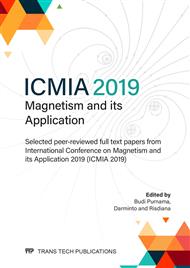p.248
p.255
p.261
p.268
p.274
p.280
p.286
p.293
p.299
Microwave Response of Gd-Doped YIG Based Y-Junction Stripline Circulator for Use at Very High Frequencies
Abstract:
This study aimed to evaluate Fe2O3 based magnetic ferrite performance and its composition using Rare Earth Oxide (REO) of Yttrium as dopant and Gadolinium as co-dopant elements. Lot of specimens were prepared through dry pressing technique, and sintered into the high temperature tube furnace up to 1450°C. Sintering duration of 5 hours results the best magnetic properties. The existence of Gadolinium element tends to improve magnetic properties of magnetic ferrite Gd-doped YIG structure. Remacomp brand Magnet-Physik was used to determine the characteristics of soft magnetic materials in the measurement frequency range of 10 Hz to 70 kHz. Microwave response was measured using the Vector Network Analysis to provide insertion loss and isolation data. The obtained insertion loss of Gd0.75Y2.25Fe5O12 is 0.4270 dB (at 3.7 GHz) and 0.2455 dB (at 4.2 GHz), while the isolation value is 11.3840 dB (at 3.7 GHz) and 17.8250 dB (at 4.2 GHz). The further experiment will be carried out to improve the microwave response and better magnetic properties of Gd-doped YIG structure.
Info:
Periodical:
Pages:
274-279
Citation:
Online since:
July 2020
Authors:
Keywords:
Price:
Сopyright:
© 2020 Trans Tech Publications Ltd. All Rights Reserved
Share:
Citation:


